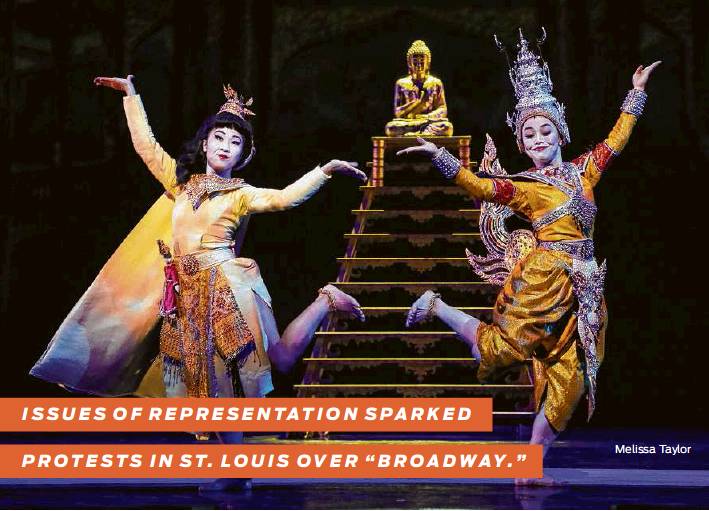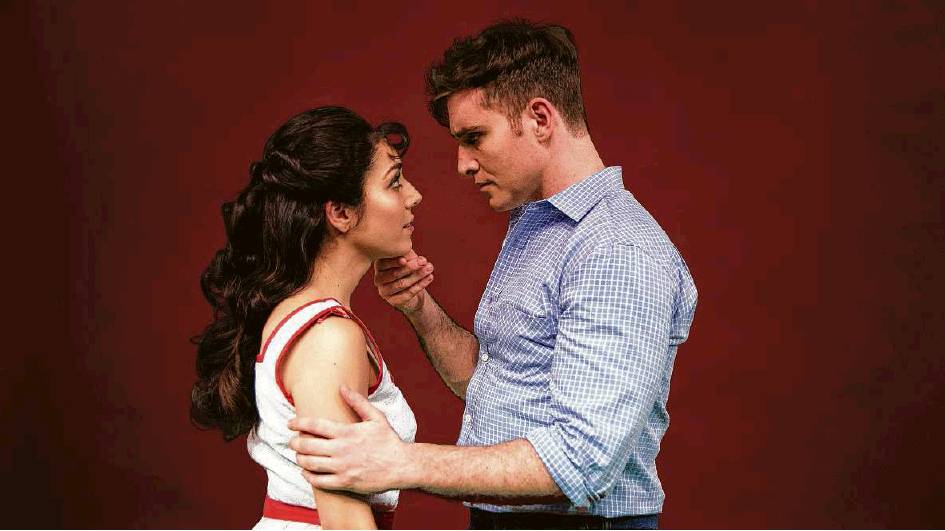COMMENTARY
THE BATTLE OVER ‘JEROME ROBBINS’ BROADWAY’
BY WEI-HUAN CHEN | STAFF WRITER
“Jerome Robbins’ Broadway,” a controversial anthology of the work of the titular choreographer, wasn’t greeted by boos during opening night last Thursday. Produced by Theatre Under The Stars and playing at the Hobby Center through Sunday, the production finished its nearly three-hour performance without protest.
In the production, a scantily clad stripper thrusts her pelvis while playing a trumpet (“Gypsy”); a man attempts to have sex with a sleeping woman (“On the Town”); a man pinches a girl’s behind without her consent (“High Button Shoes”); a man opens a door, revealing a woman in the midst of changing her clothes, also without her consent (“High Button Shoes”); and a cast of mostly non-Asian dancers presented a stereotypical vision of Asia with gongs, flashy red costumes and high-pitched, Oriental-sounding voices (“The King and I”).
The audience gave the performance astanding ovation.
The Houston run is perhaps the most prominent regional production of the Robbins’ showcase since the maligned St. Louis run. Last June, protesters were escorted off the premises of St. Louis’ outdoor theater, the Muny, during the “The King and I” portion, after they shouted “boo yellowface,” referring to the fact that the character Tuptim, a Burmese slave taken to Siam (Thailand), was played by a white actress.
The protesters were theater professionals in town for the national conference of Theatre Communications Group. Members of the Consortium of Asian-American Theatres and Artists released a statement, saying, “The Muny production included drunken sailors cavorting onstage in stereotypical Native American headdresses and plastic Hawaiian hula skirts, as well as non-Latinx actors playing the roles of Puerto Ricans in ‘West Side Story.’ ”
The statement said the production raised “larger issues about the problematic representations of Asian Pacific Americans and indeed people of color in general. The Muny and theatres of similar stature are powerful purveyors of culture. They can concoct dehumanized portrayals of people of color and those without agency by upholding and glamorizing, packaged in glitz and glitter with high production values, minstrel performances for consumption by families and children of all ages in their 11,000-seat houses.”
The protests garnered national media attention. The Muny responded with a statement of apology regarding engaging in yellow-face, saying, “Our commitment, belief, and dedication to inclusive and diverse casting, as well as honest examination of imagery and ideas in our productions, is real and passionate. Representation matters to the Muny.”
In Houston’s production, directed by Cynthia Onrubia (who also directed the St. Louis production), an Asian performer plays Tuptim and the named characters in “West Side Story” are performed by Latino actors. Yet “Jerome Robbins’ Broadway” featured no significant revisions nor additional programming or commentary to place the production’s sexist and racially insensitive overtones into a historical context. TUTS has no scheduled public panels featuring women and people of color speaking about how to contextualize mainstream American musicals of the 1940s and ’50s. (The theater did host a public event about the show as part of its Spotlight series. It can be found in the video category on Theatre Under the Stars’ Facebook page.)
The idea that art is a window into the world from which it originates is nearly universally accepted. The musical “On the Town,” about three horny sailors’ romp through New York City, was produced in 1944, nearly 20 years before the publication of “The Feminine Mystique” and 22 years before the abolishment of Jim Crow.
The works showcased in “Jerome Robbins’ Broadway” are, in other words, expressions of a demographic class whose privileges would not be challenged in the mainstream until much later, during the civil rights movement. Apart from “On the Town” co-writer Betty Comden, the musicals “On the Town,” “Gypsy,” “High Button Shoes” and “The King and I” are exclusively the machinations of white men — and, by definition, represent a white male perspective.
Yet it would be dangerous to dismiss the beauty and power of the dance showcased in the anthology — particularly the “West Side Story” suite that leaves both dancers and audiences breathless. Robbins’ choreography demanded something of the dance chorus that musicals after his time rarely did — a near-superhuman level of strength, endurance and precision.
Robbins, born Jerome Wilson Rabinowitz, was himself aminority, born into an immigrant neighborhood in Manhattan and later prosecuted as a Communist and threatened to be outed as a gay man. The ballet “Fancy Free,” which inspired “On the Town,” is the work of two Jewish geniuses, Robbins and Leonard Bernstein, that premiered less than two months before D-Day. You could say it was their way of protesting Nazism. The diverse talent in the original Broadway production of “On the Town” was unusual for its time, featuring Japanese-American dancer Sono Osato and African-American conductor Everett Lee.
As both artistic director for George Balanchine’s New York City Ballet and the creative force behind Broadway megahit after Broadway megahit, Robbins put lyricism in the bodies of everyday characters. While his dances defied the boundaries of high and low art, the stories they inhabited spoke of the danger of tribalism. “West Side Story” is nothing other than a indictment of the artificial walls we build around each other.
All this to say there’s a sad irony when Robbins, in many ways a hero of individualism, takes on the role of the colonizer. The problem isn’t that Robbins’ legacy, when protested in St. Louis, risks being distilled into the camp of anti-woke villainy, nor that, when applauded in Houston, it risks being mythologized into the canon of Great White Men. The issue is that “Jerome Robbins’ Broadway” is a dance concert that has no business being one.
The most blatantly off-color scenes in “Gypsy,” “High Button Shoes” and “The King and I” appear without commentary or context. The numbers are presented with a naive sense of purity. The second act of the show (which features the above three musicals) feels at best overlong and at worst an insult to the colossal achievement of the “West Side Story” suite that closed Act 1.
Neither the anger of a protester nor the complacent applause that followed “Gypsy” and “The King and I” can fully acknowledge Robbins’ paradoxes. But a concert carries no explicit social content to speak to either party. TUTS impressively cast and rehearsed a large, talented ensemble that did justice to Robbins’ material, but it failed to do the necessary intellectual homework to do justice to his complicated legacy. That TUTS did nothing more beyond avoiding yellowface suggests the organization sees the current conversation over identity as an act of avoidance rather than advocacy.
The engineered partisanship ingrained in these debates about the canon of dead white men already risks a distillation of art, when what both parties claim they want is a richer, more complex conversation from the other camp. Today, the tweeting, commenting and resharing of content about sensitive social issues often follows a format that amplifies the most toxic, simplistic and overly ideological voices.
A theater company, which asks audiences to turn off their iPhones and take in a single two-hour story, thus takes on a rare role today. It’s a presenter of complicated ideas in a venue without added noise. But being a last bastion against the Twitter cacophony is not an excuse not to evolve with the times. Theaters aren’t very good at knowing what to do when interruptions do occur, such as when upset theater professionals yell “boo yellowface.” They treat the incident like a goat has been set loose in a church. In fact, the protest inside their theater isn’t a wild animal at all. It’s an incredible opportunity to make their art feel alive. wchen@chron.com twitter.com/weihuanchen
“JEROME ROBBINS’ BROADWAY”
When: 8 p.m. Friday, 2 and 8 p.m. Saturday, 2 and 7:30 p.m. Sunday
Where: Hobby Center, 800 Bagby
Details: $30-$105; 713-558-8887, tuts.com

